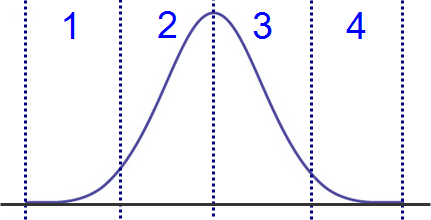Although many economists anticipated the official measurement of US economic growth in the first quarter to undergo another downward revision, they certainly weren’t expecting the huge plunge to negative 2.9%, which came in well below consensus estimates.
With such a big surprise to the downside, did the markets crash? Nope. Why not?
In short, the consensus view holds that Q1 GDP growth was largely affected by “transitory factors” and will see a much stronger pickup in the second quarter, as Janet Yellen stated in her recent press conference:
Although real GDP declined in the first quarter, this decline appears to have resulted mainly from transitory factors. Private domestic final demand—that is, spending by domestic households and businesses—continued to expand in the first quarter, and the limited set of indicators of spending and production in the second quarter have picked up. The Committee thus believes that economic activity is rebounding in the current quarter and will continue to expand at a moderate pace thereafter. Overall, the Committee continues to see sufficient underlying strength in the economy to support ongoing improvement…
Thus, the consensus view is that the contraction in first quarter GDP growth was an outlier and that, with a stronger rebound in the second quarter, the economy will not go into recession (technically defined as two consecutive quarters of negative growth).
Our own recession models support this view and show that the probability of recession is still quite low, with incoming data and leading economic indicators also in support of a more optimistic view.
If an economic recession doesn’t drag down the stock market, what other factors need to be considered?
Outside of unforseen exogenous shocks, two of the most important influences of market behavior are: 1) a sudden or ongoing increase in the price of oil due to geopolitical concerns or 2) the timing of interest rates hikes by the Federal Reserve.
Given the strong influence oil prices have on economic growth, recent events in Iraq pose a significant threat to the global economy should prices spike higher. In a recent piece, James Hamilton estimated “an oil price in excess of $150 a barrel” should ISIS gain control of key oil fields and cause major disruption.
Although he doesn’t think the US is as vulnerable to an oil shock today as in the run-up to the last financial crisis, clearly further significant increases in the price of oil due to geopolitical tensions will drag on economic growth and put pressure on the stock market.
Regarding the second main concern, the Fed is expected to fully withdraw its current program of quantitative easing (QE3) by the end of this year and has attempted to reduce the potential negative impact this may have by gradually tapering their level of accommodation. Whether this will give the market time to adjust and by how much remains to be seen, however, putting QE aside, the more important variable of monetary policy is the level of accommodation provided by the Federal Reserve through low interest rates.
Since low interest rates facilitate borrowing, leverage, refinancing, and consumption—not to mention the calculation of future cash flows for various assets—changes in interest rate levels have profound effects on both the stock market and economy.
As we have written previously (see story), interest rate cycles can be broken into four phases:
In phase 1, the Federal Reserve is transitioning from a low interest rate environment to gradual tightening. This happens as the economy starts to improve and inflation begins to rise. Think 2004 as Greenspan started to raise interest rates in quarter point increments from extremely low levels. In this phase P/E multiples and the bond market begin to peak with the historical mean return on stocks around 10%.
In phase 2, monetary policy is now much more restrictive and well into tightening mode. The economy is doing quite well and inflation is running much higher. Commodity prices begin to climb steadily and profit margins are beginning to get squeezed with rising input costs. Think 2006 and 2007 as interest rates rose to 5%. This is a deadly combo for stocks and the economy, and typically the time when investors should start worrying. (Note: We’re not yet in this phase with low economic growth and inflation.) The historical mean return for stocks in this phase is around 2.5%.
In phase 3, policy is tight, interest rates have peaked and may now be rolling over. The stock market has corrected and the economy is either in or very near recession. Think 2008. In this phase, the historical mean return of stocks is -9%.
In phase 4, monetary policy is loose once again, the economy is in recovery mode, and inflation is running low. This is the best phase for stocks with a mean return around 23%.
Interest Rate Cycle
Given the above, it is clear that we are well into phase 4 with the most important variable being how long this phase will last before the Federal Reserve moves into gradual tightening mode.
Given their current assessment of economic conditions, Yellen said they will likely keep rates low for a “considerable time” even after QE3 ends to help meet their stated goals. Furthermore, once those goals are met, they still believe economic conditions warrant lower than normal levels of interest “for some time”.
Here is Yellen again (emphasis mine):
In determining how long to maintain the current 0 to ¼ percent target range for the federal funds rate, the Committee will assess progress—both realized and expected—toward its objectives of maximum employment and 2 percent inflation. This broad assessment will not hinge on any one or two indicators, but will take into account a wide range of information, including measures of labor market conditions, indicators of inflation pressures and inflation expectations, and readings on financial developments. Based on its current assessment of these factors, the Committee anticipates that it likely will be appropriate to maintain the current target range for the federal funds rate, for a considerable time after the asset purchase program ends, especially if projected inflation continues to run below the Committee’s 2 percent longer-run goal, and longer-term inflation expectations remain well anchored. Further, once we begin to remove policy accommodation, it’s the Committee’s current assessment that, even after employment and inflation are near mandate-consistent levels, economic conditions may, for some time, warrant keeping the target federal funds rate below levels the Committee views as normal in the longer run.
Since we have already seen nearly six years of ultra-low rates, how much longer can they last?
Given the magnitude of the crisis, record levels of unemployment and debt, the best way to answer that question is by observing what the Fed did during a similar time period—the Great Depression.
How long did rates stay low then? Nearly 15 years.
As the Fed has made clear, given current economic conditions, they don’t expect to raise rates for a "considerable time". If you think our current experience is close to the Great Depression and it will take just as long to recover, then we may actually be looking at ultra-low rates for many years to come—or decades as bond king Bill Gross has stated.
Question is, what will this do to the stock market and other assets as yield-starved investors continue to chase returns?

